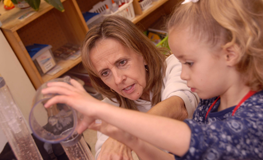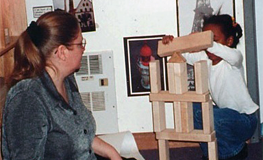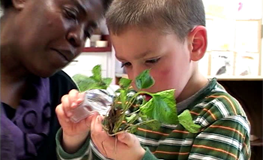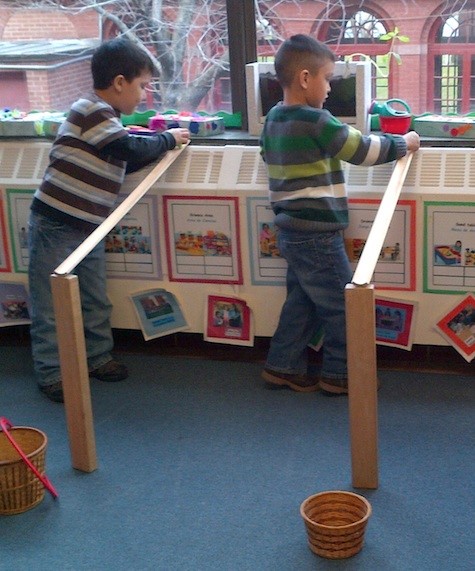All modules engage participating teachers in the pedagogy and content of science that are both developmentally appropriate for their students, and relate to grade level standards (including practices) of the Next Generation Science Standards (NGSS). Teachers also engage in learning about creating a classroom culture of inquiry. They learn how to:
- talk less in order to spend more time listening to their students’ thinking;
- formulate questions and prompts that encourage their students to think and talk;
- encourage documentation; and
- use books for science.
Exploring Water
The Water module provides opportunities for teachers to learn content and pedagogy in physical science, with an emphasis on the properties of water and the forces that interact to influence how it moves and behaves in different situations. In their classrooms, teachers will introduce children to exploration items including funnels, clear tubing, and basters that invite them to direct its flow, while drawing their attention to water’s characteristics and behavior. Teachers will facilitate children’s open and focused inquiry-based investigations of water flow, drops, and sinking/floating. These will spur explorations of gases (as children observe air as bubbles in water) and solids (as children observe them sink and float in water).

Building Structures

The Structures module provides opportunities for teachers to learn content and pedagogy in physical science, with an emphasis on the properties of building materials and the forces that interact to influence the strength and stability of structures. Structures also highlights the relationship between engineering and science. Teachers will use the engineering design process to identify building problems, brainstorm possible solutions, try them out, and evaluate the results. With their students, teachers will facilitate open and focused investigations of towers, enclosures, and ramps. They will introduce design challenges that emphasize the connections between science and engineering. Integration of mathematics will be highlighted.
Discovering Nature
The Nature module provides opportunities for teachers to learn content and pedagogy in life science with an emphasis on the characteristics, needs, life cycles, habitats, and diversity of plants and animals. Nature also highlights earth science and the connection between outdoor explorations and environmental education. With their students, teachers will facilitate open and focused investigations of living things including creating an indoor habitat for an animal, comparing and contrasting the physical characteristics and behavior of two different organisms, and observing a tree over time. Earth science explorations will emerge in the context of children’s outdoor experiences as children collect rocks and other natural materials. Close observation will be a focal inquiry skill.

Investigating Balls and Ramps

The physical science topic Balls and Ramps brings meaningful context to young students’ explorations with properties of objects and how those properties affect /are affected by forces and motion. Participating teachers are exposed to the content and pedagogy of the physical science related to forces and motion. Teachers will introduce a variety of objects (balls) and students will compare them based on their observable properties (e.g., size, weight). The teachers will then encourage students to predict, compare, and investigate how the balls will move when placed on ramps of various inclines. These investigations are a first step in helping students to describe visible movement (e.g., fast, bouncy, etc.) and encounter forces (e.g., gravity, friction) that are not as visible.
Investigating Light and Sound
In this module, teachers experience ways they can help students investigate observable phenomena related to light and sound. Teachers explore materials for their abilities to allow light to pass through completely (transparent) or partially (translucent), be absorbed, or be reflected. They explore how a light source and object combine to make shadows. They also use a variety of objects to explore the connection between vibrations and sound. These early experiences with light and sound will connect with exposure to the physical science idea of waves in later grades.

